 The Boston Marathon, the most iconic race in the U.S., is full of history, long on tradition, and features a course that punishes runners who don’t pace it wisely. The net downhill course starts in Hopkinton at 464 feet above sea level and drops down to 15 feet at the finish line in Boston. In between are quad-busting downhills, numerous small rollers, and uphills that can break your heart. The Boston course challenges even the most seasoned runners throughout the race with its constantly changing terrain.
The Boston Marathon, the most iconic race in the U.S., is full of history, long on tradition, and features a course that punishes runners who don’t pace it wisely. The net downhill course starts in Hopkinton at 464 feet above sea level and drops down to 15 feet at the finish line in Boston. In between are quad-busting downhills, numerous small rollers, and uphills that can break your heart. The Boston course challenges even the most seasoned runners throughout the race with its constantly changing terrain.
Smart pacing throughout the varied course sections can make the difference between feeling strong as you run down Boylston St. at the finish or suffering the dreaded “marathon shuffle” after the hills take their toll on your legs.
There is no better way to enjoy the marathon than to run a well-executed race that leaves you exhilarated at the finish line. In this article, we’ll provide a breakdown of the Boston Marathon course as well as tips to ensure that you correctly pace yourself to a great finish.
The Boston Marathon course is best divided into four sections. The length of each section varies and each one presents distinct physical and mental challenges. We’ll describe what to expect in each section as well as provide pacing strategies and common pitfalls.

After the bus ride to Hopkinton and the wait at the Athlete’s Village, your adrenaline is likely flowing as you wait in your corral for the starter’s gun to be fired. You’ve put it months of hard training and you’re ready to run…fast. However, don’t let the excitement of running Boston dictate your pace over first stretch. This excitement, the adrenaline rush and your fresh, tapered legs can make the first downhill section seem as if you are flying. Be cautious - many Boston Marathons have been ruined due to poor race management during this early part of the race.
The first 0.6 miles presents one of the steepest hills on the course. If you are in the first few corrals of your wave, you’ll have to make a concerted effort not to run with the lead pack. Have confidence that those runners weaving in and around you are making the foolish decision to ruin their race in the first miles. If you’re lucky, you’ll be slowed down by the crowds running in front of you. Route 135 is narrow, so it may take a few minutes for the congestion to lessen and for you to be able to reach goal pace. Don’t panic. This slowdown will actually help you later in the race as the course gets mentally and physically challenging in Newton.
After the initial drop of about 160 feet (5% grade), there will be a good sized uphill (45 feet) that takes you nearly to mile one. At this first mile marker, it’s important to check your pace.
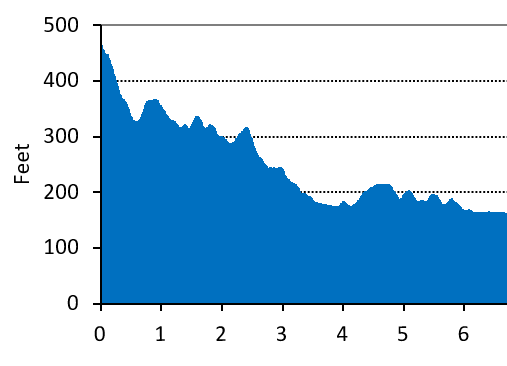
If you’re ahead of goal pace here, it’s time to slow it down. No matter how good you feel, slow it down. It’s easy to think that you can just “bank” time on these early easy miles. You’re excited to run the most prestigious marathon in the world, you have fast runners all around you, crowds are cheering you on, your legs are fresh and it all seems to so easy right now. It’s a recipe for disaster on the Boston Marathon course though. Banking time on these early miles usually means bonking on the Newton Hills or even before. Resisting the temptation to speed through the early miles can’t be emphasized enough.
If you are on or behind pace at the first mile marker, it’s okay. It means you resisted the temptation to chase those trying to make up time lost at the start or runners overcome with the excitement of the occasion. You’re going to have a much better chance of conquering Heartbreak Hill than they will. Remember: Banking means Bonking.
After reaching the first mile, you’ll continue the pattern of small rolling hills all the way to the first 10K into Framingham. There is a net drop of over 200 feet from mile one to the 10K mark. It’s not all downhill though. You will have some uphills, but you’ll lose much more elevation on the downhills than is gained on the short uphills.
There is a mile and a half stretch from about Mile 2.5 to the 4-mile mark where it is almost entirely downhill. This is another section on the course where runners may pick up the pace too early. Be sure to maintain goal pace through this section and not run too fast.
Once you reach Framingham, the course becomes flatter. You’ll still have a few hills, but nothing compared to what you just left behind and what you’ll experience after this section. If you are behind goal pace here, it is the time to slowly make up that time lost from the congested start. Be cautious though. Taking off huge chunks of time is not recommended. The most challenging portion of the course lies many miles ahead. If you are thirty seconds behind pace entering Framingham, it is possible to make up that time over the next 9.5 miles by running three seconds under goal pace in this section. However, it may be wiser to stick with goal pace, adjust your finish goal time, and make sure you run strong Newton and beyond. If you finish Heartbreak Hill feeling good, time can be made up slowly in the last few downhill miles as well.
Upon reaching the 15K mark in Natick, the course rises slightly over the next two miles until Wellesley. The elevation change is gradual, and you shouldn’t feel it much.
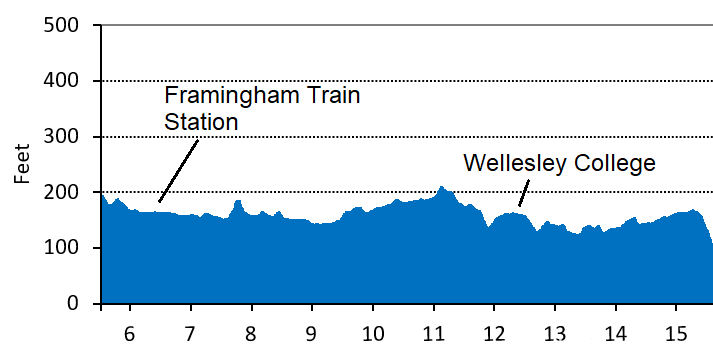
Between miles 11 and 13, you’ll experience a few more rolling hills. This time a little larger than you’ve encountered since leaving the first section of the course.
Before reaching the halfway point, you’ll encounter one of the most famous sections of the course – Wellesley College. Hundreds of Wellesley students line the security fence on the right side of the course, cheering on runners and holding signs. It’s a good mental break before taking on the most challenging part of the Boston course. The course bends as you approach Wellesley College, so you’ll hear the screams well before seeing the enthusiastic crowd.
The overly fervent crowd can push you to unknowingly increase your pace here. Enjoy the experience, but remember you still have more than thirteen miles to go.
After leaving the halfway point at Wellesley, the course is relatively flat until the next section.
Starting at Mile 15.5, the Boston Marathon course becomes much more challenging. Just before hitting 25K, you’ll encounter a sharp downhill into Newton Lower Falls. It will feel very steep on your tiring legs as you lose 150 feet of elevation over the half-mile downhill (5.5% grade). Concentrate on your form and on not braking as you glide down the hill.
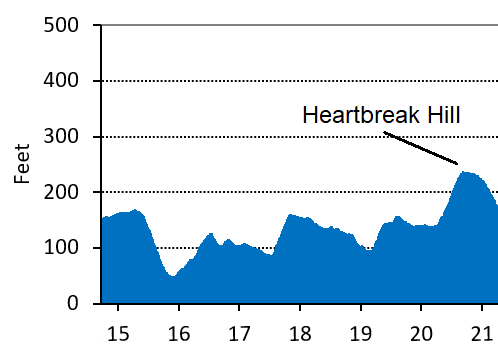
Shortly after this long downhill, the course crosses over I-95 just after Mile 16. Although not considered one of the “Newton Hills,” it is long (0.6 miles) and difficult after 16 miles and the preceding steep downhill.
This hill is the first major check to see if you’ve properly trained for the challenge of the Boston course or if you went out too fast on the early hills and trashed your legs. The road becomes wider and for probably the first time you’ll see people walking. If you’ve paced yourself well up to this point, you’ll see the familiar singlets of runners who flew by you during the first few miles as you reel them back in.
Once you crest the I-95 overpass hill, the course has some slight rolling hills before you turn onto Commonwealth Avenue and face the first of the famed Newton Hills. There are typically several gel stations along this section and the crowds begin to swell. For many this mile before the start of the first Newton hill is mentally tough. In the last couple of miles, you’ve finished a quad-punishing downhill followed by your first big uphill, your legs are tired and you have 10 miles to go – three of which cover the Newton Hills. In addition, you’ll likely have to dodge fellow runners cutting to the side of the course to get to the gel stations, sidestep those stopping in front of you to walk, and avoid spectators crossing the road. Stay focused on the task ahead of you and ignore the distractions.
1st Newton Hill: Once you make a right turn onto Commonwealth Avenue at the Newton Fire Station, you’ll be greeted with the first of the three Newton Hills.
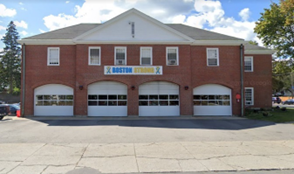
This first hill is from Mile 17.6 to 17.9 and rises 70 feet. Just as with the previous hill, you’ll see a lot more people walking this section after starting too fast or under-training for the hills. The road narrows here to two lanes with spectators encroaching on the side of the course, so it may feel more congested.
After mile 18, you’ll have a significantly long downhill section. It should be your fastest split through Newton. It’s a good respite after the I-95 hill and the first hill in Newton. Don’t push the pace here. You still have two nearly back-to-back uphills ahead. Let the faster pace come without increasing your effort.
2nd Newton Hill: You’ll reach the second Newton Hill at Mile 19.2. It is only four-tenths of a mile long and rises 75 feet. At this point it may feel much longer and much steeper though. After a mostly flat three-quarters of a mile (Mile 20.3), you’ll reach the base of famed Heartbreak Hill.
Heartbreak Hill: If you ran Heartbreak during a normal training run, you wouldn’t find it too difficult. It’s half a mile long and gains 91 feet of elevation – about a 3.5% grade. However, when you run up Heartbreak after 20 miles and after three other hills in the previous 4 miles, the difficulty increases tremendously. How well you tackle Heartbreak will depend on your course management and training.
To conquer Heartbreak, you have to be mentally tough, especially if the course has already taken its toll. Realize that, depending on your pace, it will only last 3-5 minutes – a brief moment in time on your training runs back home. Concentrate on your cadence, read the chalk messages written on the road, do anything to disassociate from the hill in front of you. However, if you are feeling good, take in the experience. The crowds will be enthusiastic and encouraging along the hill and feel confident knowing that you got the best of Heartbreak.
Aside from a few spectators holding signs, there is no significant monument telling you that you’ve finished Heartbreak Hill. You’ll feel it as the road flattens, dips for a bit and rises a few feet as you come to Boston College. You’ve conquered Heartbreak and you can relish in the fact that it really is almost “all downhill from here.”
The final section of the Boston Marathon course is primarily downhill. The course drops from approximately 230 feet to 15 feet over these last five miles with only a few short inclines along the way. If the early downhill miles and the Newton Hills haven’t trashed your legs, this section can be fast. Take an inventory on how you feel and decide whether to increase your intensity slightly or wait until later in the race.
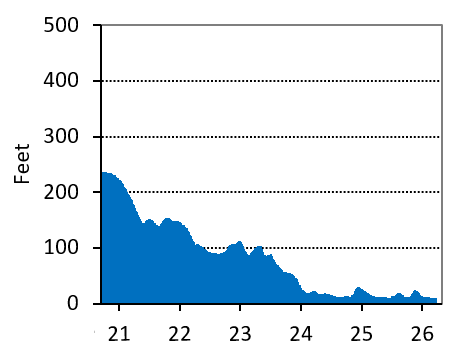
Once you crest Heartbreak Hill and pass the 21-mile mark, you’ll be greeted by the enthusiastic crowds at Boston College and a moderately steep half-mile downhill run towards Boston. You’ll lose nearly all the elevation you gained climbing Heartbreak Hill over this stretch.
After passing Boston College, spectator access is limited for about the next mile (21.4 to 22.3) as you run alongside the Green Line T tracks on your left and the narrow sidewalk on your right heading toward Cleveland Circle. The crowds are thin here, so you will have to concentrate on pushing yourself through this segment.
It becomes a mental game for the next two-and-a-half miles from the turn at Cleveland Circle (Mile 22.3) to the Mass Pike overpass just before Mile 25. The course is relatively straight and aside from a couple of small inclines, it is downhill. This provides great site lines for the course in front of you. You can see the mile/km marker flags in this section from significant distances which can be disheartening when you realize they are still minutes away. In addition, the iconic Citgo sign, located a mile from the finish, can be seen from a mile away depending on how many leaves are on the trees.
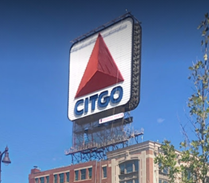
Just before Mile 25 and as you approach Kenmore Square and the Citgo sign, you’ll encounter the bridge over the Mass Pike. It’s not a long hill and it’s not a particularly steep hill, but it can be one more cruel twist the Boston course throws at you before the adrenaline of the last mile takes over.
You can break the section leading up to and over the Mass Pike overpass into Kenmore Square by focusing on the three distance markers you’ll encounter. First, as you start the incline leading up to the overpass, you’ll reach the 40K marker, 250 yards later on the overpass uphill, you’ll hit the 25 Mile marker, and shortly after you come down the overpass hill and turn into Kenmore Square, you’ll reach the 1-mile-to-go marker. In addition, you’ll have a water station on the overpass. Focusing on reaching these markers can help you push your way past this (almost) last hill.
Once past the overpass, the crowds are several rows deep and loud in Kenmore Square (Mile 25.2). Red Sox fans stream into Kenmore to cheer on runners after the traditional late morning baseball game ends. As you leave Kenmore and the Citgo sign behind you, the course is flat until you reach the Mass Ave. underpass at Mile 25.5. The darkness and silence of the underpass can be disorienting, but it is short and leads you up to the final stretches of the race.
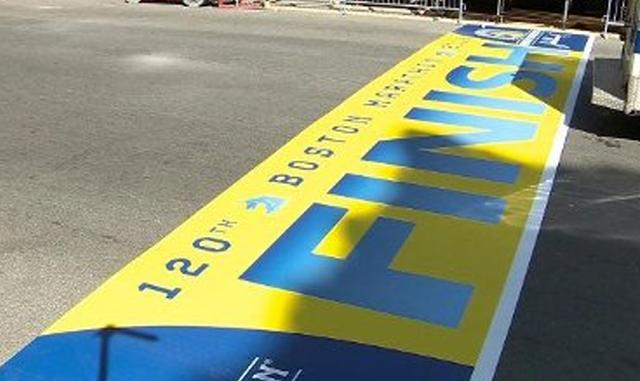
Shortly after exiting the underpass, you’ll make the right turn onto Hereford St. You are greeted by a wave of cheering spectators and the final uphill on the course – a short 200 yard incline. By this time, adrenaline has taken over and you may not even notice you’re running uphill.
After the short run up Hereford, you’ll turn left onto Boylston St. and enter the final stretch. As you make the turn, you’ll be able to see the finish banner in the distance and will be greeted by thousands of cheering spectators on both sides of the road. The finish may look far away, but the straight final section allows you to savior the spectacle of the Boston Marathon over the last third of a mile of the race.